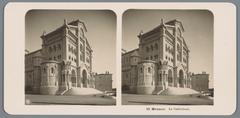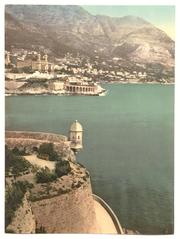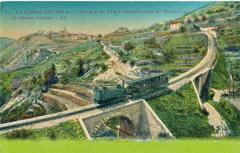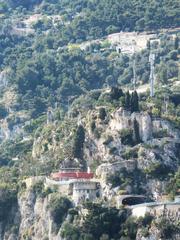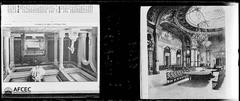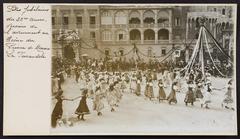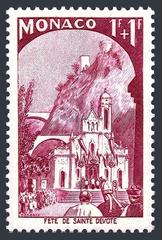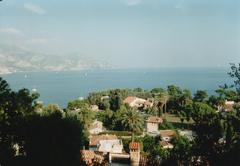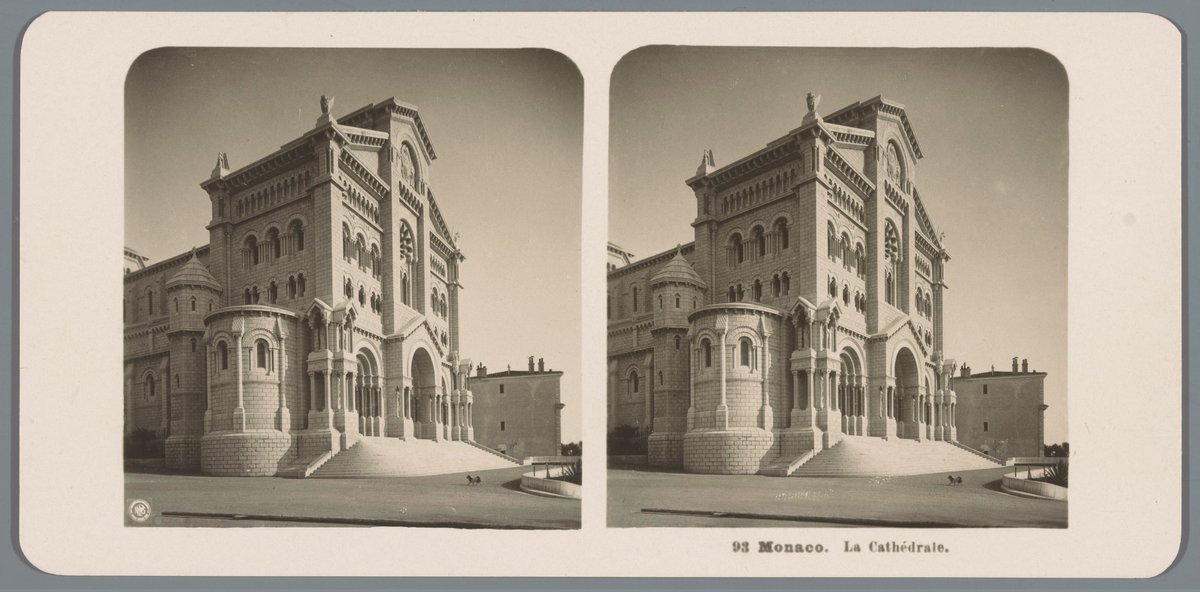
Cathédrale Notre-Dame-Immaculée: Visiting Hours, Tickets, and Historical Sites in Monaco
Date: 18/07/2024
Introduction
The Cathédrale Notre-Dame-Immaculée, also known as the Cathedral of Our Lady of the Immaculate Conception, stands as a magnificent testament to Monaco’s rich heritage, both historical and spiritual. Not only is it a marvel of Romanesque-Byzantine architecture, but it also serves as a pivotal cultural and religious landmark in Monaco. Initially constructed to replace a 13th-century Romanesque church that had become insufficient for the principality’s growing population, this grand cathedral was brought to life under the vision of Prince Charles III, with the renowned French architect Charles Lenormand at the helm (Monaco Tourism). The cathedral’s pristine white stone facade, quarried from La Turbie, creates a striking contrast against the vibrant Mediterranean backdrop, making it a beacon visible from afar. Inside, visitors are greeted by high vaulted ceilings, intricate mosaics, and stained-glass windows that tell biblical stories through a kaleidoscope of colors. Beyond its architectural splendor, the cathedral is deeply intertwined with the history of the Grimaldi dynasty, housing the tombs of Prince Rainier III and Princess Grace Kelly, among others. This guide aims to provide a comprehensive overview of Cathédrale Notre-Dame-Immaculée, encompassing its storied past, architectural significance, visitor information, and more, making it an essential resource for anyone planning to explore this iconic monument.
Table of Contents
- Introduction
- A History Etched in Stone - The Story of Cathédrale Notre-Dame-Immaculée
- A Symphony of Stone and Faith
- A Royal Resting Place and a Spiritual Heart
- Visitor Information
- Special Events and Community Engagement
- Nearby Attractions
- Accessibility
- FAQ
- Conclusion
A History Etched in Stone - The Story of Cathédrale Notre-Dame-Immaculée
Before the current cathedral graced Monaco’s skyline, a 13th-century Romanesque church dedicated to Saint Nicholas stood on the same site. This humble structure, however, couldn’t accommodate Monaco’s growing population and ambitions. Prince Charles III, eager to leave his mark on the rapidly developing principality, envisioned a grander place of worship.
Construction of the Cathédrale Notre-Dame-Immaculée began in 1875, spearheaded by the renowned French architect Charles Lenormand. Lenormand, known for his work on the Basilique Notre-Dame de la Garde in Marseille, chose a Romanesque-Byzantine style for the cathedral, a departure from the prevailing architectural trends of the time. This unique blend, characterized by rounded arches, intricate mosaics, and a sense of soaring grandeur, would come to define the cathedral’s aesthetic.
A Symphony of Stone and Faith
Romanesque Revival Dominance
Designed by French architect Charles Lenormand, the cathedral prominently features the Romanesque Revival style, inspired by the Romanesque architecture of the 10th to 12th centuries. Key characteristics include:
- Rounded arches: Noticeable in the cathedral’s windows, doorways, and interior arcades, rounded arches are a hallmark of Romanesque architecture.
- Thick walls and piers: The cathedral’s robust structure, with its substantial walls and supporting piers, reflects the Romanesque emphasis on solidity and strength.
- Simple, geometric forms: The overall design favors clean lines and geometric shapes, creating a sense of harmony and balance.
Local Stone and its Significance
The cathedral incorporates white stones from La Turbie, a material deeply rooted in Monaco’s landscape. This choice serves several purposes:
- Aesthetic appeal: The pristine white stones lend the cathedral a striking appearance, especially against Monaco’s azure skies and verdant hills.
- Local connection: Using local stone grounds the cathedral within its geographical context, forging a visual link between the structure and its surroundings.
- Historical continuity: The choice of La Turbie stone echoes its use in earlier structures in the region, subtly acknowledging Monaco’s architectural heritage.
Interior Highlights and Artistic Embellishments
Stepping inside reveals a serene space adorned with artistic elements that enhance its spiritual ambiance:
- Carrara marble altar: The high altar, crafted from exquisite Carrara marble, commands attention with its elegance and grandeur.
- Bishop’s throne: Made from a single block of white stone, the bishop’s throne embodies both simplicity and authority.
- Louis Bréa’s altarpiece: Dating back to 1500, the altarpiece by Louis Bréa is a significant artistic treasure, offering a glimpse into the region’s artistic heritage.
The Bell Tower: A Beacon Overlooking Monaco
Constructed in 1903, the 54-meter tall bell tower houses a carillon of 47 bells, each contributing to the harmonious chimes that resonate across Monaco. Its height and prominent location offer panoramic views, making it a visual landmark.
A Royal Resting Place and a Spiritual Heart
Religious Center
As the cathedral of the Roman Catholic Archdiocese of Monaco, Cathédrale Notre-Dame-Immaculée serves as the principal place of worship for the principality’s Catholic population. It is a focal point for religious services, celebrations, and events, including important dates in the liturgical calendar like Easter and Christmas.
Royal Weddings and Burials
The cathedral holds a special place in the history of the Grimaldi family, Monaco’s ruling family. It has been the venue for significant royal events, most notably weddings and funerals. The most famous event was the 1956 wedding of Prince Rainier III and Grace Kelly, an event that captured global attention and forever linked the cathedral with the glamour of Hollywood. The cathedral is also the final resting place of numerous members of the Grimaldi dynasty, including Prince Rainier III and Princess Grace, making it a poignant site for those interested in Monegasque history.
Visitor Information
Hours
The cathedral is open to visitors from 8:30 AM to 6:00 PM daily. Note that visiting hours may vary on religious holidays and significant events.
Tickets
Entry to the cathedral is free. However, donations are appreciated to help with the maintenance and preservation of this historic site.
Travel Tips
- Dress modestly as this is a place of worship.
- Photography is allowed, but flash and tripods are prohibited.
- Guided tours are available for those interested in a more in-depth exploration of the cathedral’s history and architecture.
Special Events and Community Engagement
The cathedral hosts several events throughout the year, including the Monaco International Organ Festival, which attracts renowned organists from around the world. These events highlight the cathedral’s role as a cultural hub. Additionally, the cathedral serves as a gathering place for the community, hosting concerts and religious services that bring people together.
Nearby Attractions
- Palais Princier de Monaco: A short walk from the cathedral, this historic palace offers stunning views and a glimpse into Monaco’s royal heritage.
- Oceanographic Museum: Located nearby, this museum is a must-visit for marine life enthusiasts.
- Monaco-Ville: Explore the charming old town with its narrow streets, shops, and cafes.
Accessibility
The cathedral is accessible to visitors with reduced mobility. There are ramps and designated areas within the cathedral to ensure a comfortable visit for all guests.
FAQ
- Q: What are the Cathédrale Notre-Dame-Immaculée visiting hours?
- A: The cathedral is open from 8:30 AM to 6:00 PM daily, but hours can vary on religious holidays and significant events.
- Q: Do I need to buy tickets to enter the Cathédrale Notre-Dame-Immaculée?
- A: No, entry is free, but donations are welcome.
- Q: Are there guided tours available?
- A: Yes, guided tours are available for those interested in learning more about the cathedral’s history and architecture.
Conclusion
Today, the Cathédrale Notre-Dame-Immaculée stands as a symbol of Monaco’s enduring faith, architectural prowess, and rich history. It serves as a reminder of the principality’s past, a vibrant center for its present, and a beacon of hope for its future. Whether you’re drawn to its architectural splendor, its historical significance, or its spiritual aura, a visit to the Cathédrale Notre-Dame-Immaculée is an experience that will stay with you long after you’ve left the shores of Monaco. Plan your visit today and immerse yourself in the profound history and beauty of this iconic monument (Monaco Tourism).
References
- Visiting Cathédrale Notre-Dame-Immaculée - History, Tickets, and More, 2024, Monaco Tourism (monaco-tourism.com)
